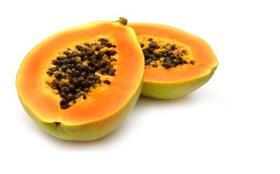
In what was the first of its kind for the papaya industry, the Department of Agriculture, Fisheries and Forestry (DAFF) surveyed 101 Australians in Brisbane to provide an insight into consumer attitudes towards the tropical fruit.
The results were unveiled in Innisfail on 11 February, covering the supply chain, post-harvest disease management and consumer preferences.
“We wanted to find out which varieties on the market, or imported, offered consumers the best taste and flavour, so we undertook some consumer sensory work,” explained Yan Diczbalis, principal horticulturalist at DAFF.
“The main objective was trying to determine the desirable and non-desirable qualities of papayas in the Australian markets, which involved sensory components and profiling products,” added DAFF consumer and sensory scientist Philippa Taylor.
Overall, the desirable qualities were a darker, burnt orange colour of the papaya flesh; a sweet, caramelised flavour described as similar to a ripe rockmelon; and a velvety texture that dissolved in the mouth, with a sweet aftertaste. The non-desirable qualities were a bitter, metallic and musky taste, with some descriptions likening it to a vomit-like aftertaste; a lighter yellow-coloured flesh; and a tougher texture.
More than half (55 per cent) of those surveyed were categorised as ‘red papaya fans’, who had rarely eaten the fruit, didn’t purchase it, but loved it and said they would try it again. The second categorisation was labelled ‘colour-blind lovers’ who were older and had regularly eaten the fruit from a young age. The final 15 per cent didn’t like papaya, wouldn’t buy it and would probably never buy it.
Taylor said the standout variety was the red-fleshed CG Red, while the least favourite was the yellow-fleshed Hybrid 1B, which is one of the most widely produced in Australia.
“The industry started off based around the yellow-fleshed varieties, with the most common varieties Hybrid 1B and Hybrid 13 – both of which can have quite a musky aftertaste. Older Queenslanders know and like the yellow-fleshed papaya, and are the main purchases. But now, with a younger popular, the red-fleshed papaya has a broader acceptance,” Diczbalis told Fruitnet.“Papaya is not commonly known in Australia and one of the biggest issues is that a lot of people don’t know what papaya is.'
DAFF said there had been a fair bit of interest in the study, and could be key to leading to an improvement in varieties produced in Australia.
“There is huge scope for future studies, and the benefits for both growers and consumers will grow exponentially,” said Taylor. “This study allows us to scope the direction for future growth. It used to be that consumers would just get what the growers produced, but now things have flipped and consumers have expectations, and using consumers as an indication of the future market is an extremely useful tool to have.”
Diczbalis agreed, adding that a potential past mistake was relying on breeders for preferences in varieties, citing the widely grown, but less popular in terms of taste, 1B Hybrid. “We haven’t solved any great mysteries, but I think this study could be used as a guide for future breeding and selection,” said Diczbalis. “This is the first time, bar some simple taste and question surveys, that we have an understanding of consumers and their preferences of textures, colours and flavours.”
The research was funded by the Australian Centre for International Agriculture Research (ACIAR), Pacific Agribusiness Research for Development Initiative (PARDI), Trade and Investment Queensland and DAFF.






No comments yet